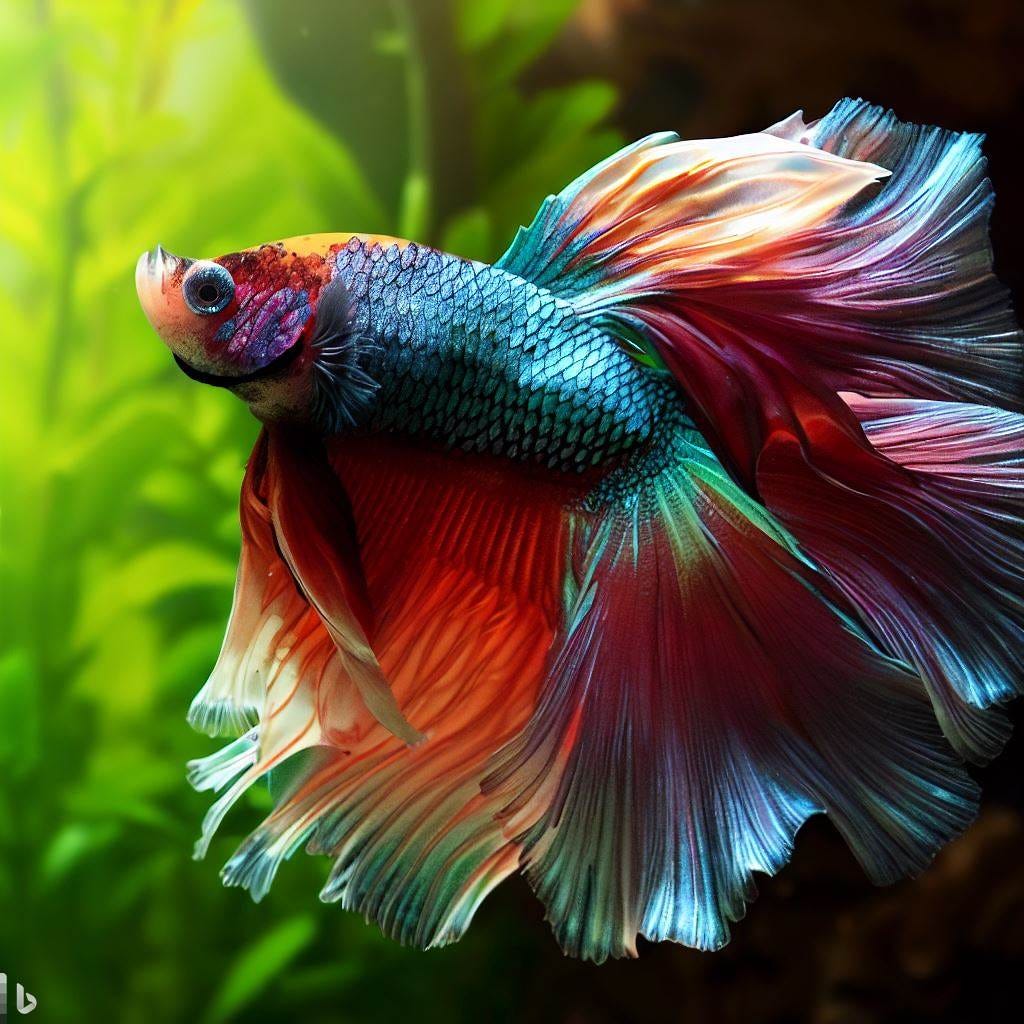Betta Eye Problems
Betta fish are captivating creatures that make wonderful pets, but like all living beings, they can experience health issues. One area that requires attention is their eyes. Understanding betta eye anatomy and recognizing potential problems is crucial for ensuring their well-being. In this guide, we’ll delve into the world of betta eye health, shedding light on common issues and offering guidance on prevention and treatment.
If your betta is suffering from eye trouble, consider checking out our betta fish care guide which talks about these issues and their treatment. Otherwise read this post because we dive into some common eye issues you might notice with a betta fish.
Common Betta Eye Problems
| Eye Problem | Description |
|---|---|
| Popeye (Exophthalmia) | One or both eyes bulge outwards, often caused by poor water quality, injury, or infection. |
| Cloudy Eye | Eye becomes cloudy or opaque, possibly due to bacterial infection, parasites, or injury. |
| Eye Flukes | Small parasites attaching to the eye, causing irritation and inflammation. |
| Cotton Wool Disease | Fungal infection affecting the eyes, causing swelling and a white, cottony growth. |
- Popeye (Exophthalmia): One of the most noticeable eye issues in bettas is Popeye, a condition where one or both eyes protrude or bulge outward. This bulging can be caused by bacterial infections, injuries, poor water quality, or even a gas bubble disease. Along with the bulging, you might observe cloudiness, redness, lethargy, and a decreased appetite in your betta.
- Cloudy Eye: A cloudy or hazy appearance over the eye is another common problem. This is often a result of bacterial or fungal infections, parasites, injuries, or subpar water conditions. Your betta might also experience redness or swelling around the eye.
- Other Eye Issues: Bettas can also develop cataracts, which appear as cloudiness within the lens of the eye, or corneal ulcers, which are open sores on the cornea. They can also develop a cotton-like appearance, and eye flukes.
PopEye
Eye problems can be very dangerous if you don’t take action. Click here.
Popeye, or exophthalmia, is a condition where one or both eyes of a betta fish swell and protrude abnormally from the head. This condition can be caused by infections, physical trauma, or poor water quality. If left untreated, can lead to blindness or even eye loss.
Popeye is a pretty obvious issue – see the picture below.

Normal Betta Eyes vs Popeye
Take a look at the table below which compares normal healthy betta eyes vs bettas suffering from popeye. We cover size, clarity of the eye, behavior changes, causes, treatment, and more.
| Feature | Normal Betta Eyes | Popeye (Exophthalmia) |
|---|---|---|
| Size & Shape | Proportional, round, and symmetrical | One or both eyes are swollen and bulging abnormally |
| Clarity | Clear, no cloudiness or discoloration | Cloudy, white, red, or hazy appearance |
| Symmetry | Both eyes are the same size and shape | One or both eyes may be larger or deformed |
| Fluid Retention | No excess fluid buildup | Eye may have fluid accumulation, appearing swollen |
| Behavior | Responds to movement and light normally | May show lethargy, reduced vision, or lack of response |
| Causes | Healthy conditions, no infections or injuries | Bacterial/fungal infection, injury, or poor water quality |
| Treatment Needed? | No treatment necessary | Requires clean water, salt baths, and possibly antibiotics |
| Risk of Eye Loss? | No risk | In severe cases, the eye may rupture or fall out |
| Prevention | Regular water changes, safe tank environment, balanced diet | Maintain clean water, avoid sharp objects, quarantine new fish |
Click Here to Heal Betta Fish Eyes
Normal Betta Fish:

- Eyes are clear and symmetrical.
- No bulging or protruding eyes.
- Healthy appetite and active swimming behavior.
Betta Fish with Popeye:

- One or both eyes are swollen and protruding.
- Eyes may appear cloudy or discolored.
- Often accompanied by redness or inflammation around the eye.
- Fish may exhibit lethargy, loss of appetite, and difficulty swimming.
Treating and Preventing Betta Eye Problems
Seeking Professional Help: If you notice any abnormalities in your betta’s eyes, it’s crucial to consult a veterinarian who specializes in fish. They can diagnose the issue and recommend treatment.
Home Care and Remedies: Depending on the cause, you can try some home remedies while awaiting veterinary advice. For mild cases of Popeye, Epsom salt baths can sometimes help reduce swelling. If the problem is related to water quality, immediate partial water changes and addressing the root cause are essential. It’s also important to quarantine any affected fish to prevent the spread of infection.
Cloudy Eye
A hazy or opaque appearance in one or both of your betta’s eyes is indicative of a cloudy eye. This condition often stems from bacterial or fungal infections, parasites, injuries, or poor water quality. Accompanying symptoms may include redness or swelling around the eye, lethargy, and a decreased appetite.
Treatment and Prevention:
- Water Quality: If water quality is the culprit, immediate partial water changes and addressing the underlying issue (such as ammonia spikes or high nitrite levels) are crucial.
- Medication: For bacterial or fungal infections, consult a veterinarian for appropriate medication. Antifungal or antibacterial treatments might be necessary.
- Quarantine: Isolate the affected betta to prevent the spread of infection to other fish in the tank.
- Supportive Care: Maintain pristine water conditions, ensure adequate filtration and aeration, and feed a nutritious diet to bolster your betta’s immune system.
Eye Flukes
Eye flukes are tiny parasites that latch onto a betta’s eyes, causing irritation, inflammation, and discomfort. You might observe your betta rubbing their eyes against objects or flashing (darting around erratically) in an attempt to dislodge the parasites.
Treatment and Prevention:
- Medication: A veterinarian can prescribe anti-parasitic medication to eliminate eye flukes.
- Quarantine: Isolate the affected betta to prevent the spread of parasites to other fish.
- Water Changes: Perform frequent partial water changes to help reduce the number of parasites in the tank.
- Cleanliness: Maintain a clean tank environment to minimize the risk of parasite infestations.
Cotton Wool Disease
Cotton wool disease, a fungal infection, can manifest as white, cottony growths on your betta’s eyes, causing them to appear swollen and irritated. This condition often arises due to stress, poor water quality, or a weakened immune system.
Treatment and Prevention:
- Medication: Antifungal medication prescribed by a veterinarian is typically necessary to treat cotton wool disease.
- Water Quality: Improve water quality by performing frequent water changes and ensuring proper filtration.
- Stress Reduction: Minimize stress by providing a suitable environment with ample hiding places and avoiding overcrowding.
- Quarantine: Isolate the affected betta to prevent the spread of the fungal infection.


